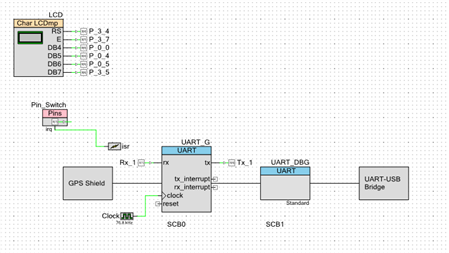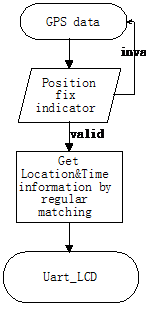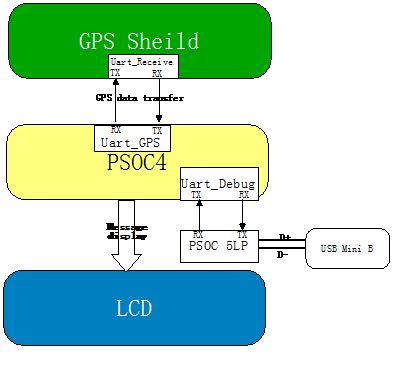Hello!
In today’s example we are building off of our earlier we posted this week. Today’s example uses the MediaTek GPS GTPA010 module. This module provides the built in GPS chip set and patch antenna on a PCB board. You can either purchase the GPS module or a board from the PMOD folks.
For more information on the GPS data stream please have a look at the following Arduino GPS tutorial web page. On this web page they discuss the functionality of the GPS modules and the NMEA data structure. It can be helpful for people new to GPS and embedded designs targeting GPS modules.
Also note that you can directly connect the PSoC 5LP UART connections to the GPS module to view the output using a Hyperterminal program or use a third part GUI that reads GPS data over a COM port.
Forum Post Attachments:
At the bottom of this post we are including the following items:
- Example Project Zip File
- Project Images
Components Used:
The user can download the example project at the bottom of this post. The project uses the following list of Creator Components:
- Char LCD
- UART (x2)
- CyPins
- ISR
- CyClock
Firmware Description:
The main.c firmware is included in the example project. Please review the commented sections for more details.
The firmware for this PSoC 4 example pulls in GPS data from the target GPS module and displays the parsed location on an LCD module. The PSoC 4 receives the GPS data via UART from the GPS module. The data packets received from the GPS module will be then displayed on an LCD screen.
The following image is an example of the firmware flow. The firmware checks to see if a valid position fix is obtained. If a valid fix is found then the data is then parsed and displayed on the LCD module.
You will notice in the design we have left in the second UART component for any debug work you may want to conduct with the example. You can use the USB-UART on the PSoC 5LP to perform any debug work or visualization if you do not have an LCD module to plug into the example. Please see the example from the other day on how enable the . To use the debug UART you will need to de-comment certain sections of the example code.
Hardware Connections:
For this example the user will need to connect GPS module to the UART component outputs.
Next connect an LCD module using a bread board and wires. This section is not necessary since you can use the second UART in the example to send data using the USB-UART bridge on the Pioneer board and see that data using a hyperterminal application.
Test Your Project:
Program the example into the Pioneer board. Connect the UART to the GPS module. View the data displayed on the LCD or view the data sent over the UART bridge.
I hope this example can help you in your design.
Best,
Matt



